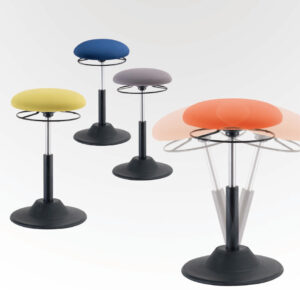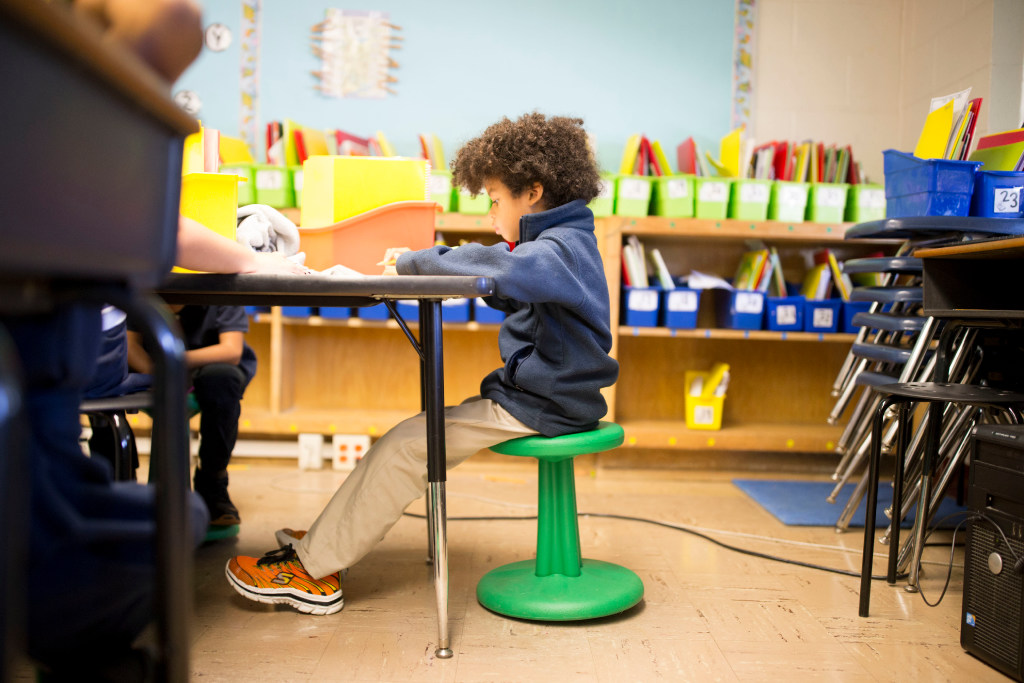Today, wobble stools and other types of active/ergonomic seating are being introduced within the classroom. These stools are far from the rigid and traditional seating once used in educational spaces. Instead, they offer a fun approach to learning and encourages movement while seated. The stools come in various colors; they are height adjustable and have a round ergonomic base that allows users to rock, tilt, and lean as they sit and perform other activities.
Learning & Attention Disabilities are Prevalent
Allowing students to move while seated in school may seem counterproductive to learning and focusing goals. However, studies show that movement is essential for a child’s development and health. When children get physical activity and move around, they stimulate their brains and improve their cognitive and motor skills. Nowadays, students are getting significantly less physical activity due to extended screen time, shorter recesses, and outdoor playtime. As a result, children are fidgeting more, and their attention spans are increasingly getting shorter. These reductions in physical activity during the school day are inhibiting students from learning and focusing. It affects their neurological systems and fosters learning disabilities, whether severe and diagnosed or situational, due to a child’s inability to stay engaged.
According to Angela Hanscom, a pediatric occupational therapist, there has been a rise in sensory and motor issues among children in the past 30 years. Children are having trouble paying attention in school and are more easily agitated and frustrated [1]. The National Center for Learning Disabilities says that 1 in 5 children have learning and attention issues, and only a small subset of people with learning disabilities receive specialized instruction and accommodations [2]. The wobble chair is designed to increase physical activity when people are meant to be seated for a prolonged period.

Features of the Wobble Stool
One of the main features of the wobble chair is that it has a rounded base that allows the user to move in many ways while seated. The top of the wobble chair can swivel 360°; users can lean, tilt, and rock. These movements promote blood flow throughout the user’s body and send more oxygen to the brain. When the brain receives more oxygen, cognitive and retention skills are improved. Students who use the wobble chair will thus be able to focus more while learning. All students can benefit from using wobble chairs as they can help anyone increase their ability to focus, including those with ADHD, Autism, and other disabilities. This product is accessible along the lines of utility, usability, and accessibility. It is inclusively designed to meet the needs of all students with varying levels of learning and attention disabilities. When viewed from this angle, the wobble chair aligns with the social model of disability. If schools replace traditional seating with active ones, the classroom becomes more accessibly designed for all students, including those who have trouble learning and focusing. Right now, schools that continue to have traditional seating make it difficult for students with attention deficits and learning disabilities to thrive academically.

Another feature of the wobble chair is that the stool is height adjustable and can accommodate people of different ages and sizes. All a user has to do is push or pull one button or lever depending on the wobble stool. To adjust the height is very simple for the user. Being able to adjust the height of the wobble stool affords the user with better posture while seated. When you adjust the level of your seat, you change the angle of your hip joint, which can modify the degree of the curve of your back. A chair that is too high or too low can cause people to have back problems later on and can affect their mobility. Wobble chairs can therefore be used as a tool to correct or prevent users from having poor posture. When used to avoid or correct such disabilities, the wobble chair can align with the medical model of disability. The wobble chair can be seen as a treatment or tool for poor posture and back problems and a device that could increase a user’s focus.

The wobble stool is also accessible in terms of desirability. Children who use the wobble stool and other active seating are excited to use it as it is a fun approach to sitting. It takes a mundane activity and makes it enjoyable. However, it is also desirable to their parents, educators, and even bosses as they increase blood flow and impact one’s focus and productivity. The only drawback in the accessibility of the wobble stool is that they are expensive. They range from $40 to over $200. Many schools or workplaces with a fixed budget may not see it financially worth it to incorporate wobble stools in these spaces. However, if we want to make these environments more accessible so that all students and employees can participate better in society, we need to advocate on their behalf.
